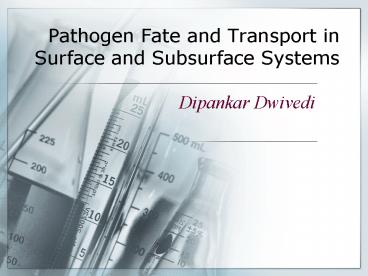Pathogen Fate and Transport in Surface and Subsurface Systems - PowerPoint PPT Presentation
1 / 27
Title:
Pathogen Fate and Transport in Surface and Subsurface Systems
Description:
First typical scenario is based on an ideal system as per Regulations. Texas Administrative Code ... Except one all were of type III. Surface Profile. Lake ... – PowerPoint PPT presentation
Number of Views:86
Avg rating:3.0/5.0
Title: Pathogen Fate and Transport in Surface and Subsurface Systems
1
Pathogen Fate and Transport in Surface and
Subsurface Systems
- Dipankar Dwivedi
2
Overview
- Introduction
- Background Information
- Objectives of the Study
- Methodology
- Expected Results
- Conclusions
- Limitations / Problems
3
Introduction
- Upper part of Brazos River (North Central Texas )
- Possum Kingdom
- Lake Whitney
- Lake Granbury
- 250,000 people in more than 15 cities
- The population is increasing 16 percent every year
4
Introduction
- Hood County, TX
- Middle Brazos-Palo Pinto watershed
- Cataloging Unit 12060201
Lake Granbury Watershed with three Subbasins
Source David Harkins, Ph.D., P.E., Espey
Consultants, Inc.
5
Introduction
- Hood County
- 425 square miles of the north central plains of
Texas - The county's center point
- 3227' north latitude 9747' west longitude.
- The eastern and west central part soil types
- brown, red, or dark loam
- The remaining soils
- red or mottled loam and sand
6
Background Information
- Contaminants such as
- pathogenic bacteria
- nutrients
- organic matter
- Major contributors to the degradation of the
water resources
7
Background Information
- Contaminant Transport in Surface Water in
- Vadose Zone- physicochemical processes
- diffusion
- convection
- coagulation flocculation
- sorption desorption
- Presence of colloids- a synergistic effect
- colloid concentration
- size
8
Background Information
- Vadose Zone
- relatively harsh conditions
- Water
- Nutrients
- Temperature fluctuations
- constrained spaces,
- fragmented aquatic habitats
- Highest prokaryotic density of all biosphere
compartments
Radiation sheltering
9
Background Information
- Contaminant transport in surface water bodies and
vadose zone
Source Ground Water and Surface Water A Single
Resource. USGS circular 1139
10
Background Information
- Modeling of physical and hydrological processes
in the vadose zone- Remarkable advances - The role of microbiological activities
- regulating micro- and macro-scale fluxes
- potential impacts on porous media properties
- Alterations in soil hydration status
- Microbial responses
- physiological mechanisms
11
Issue Being Investigated
- Lake Granbury's covesshallow bodies of water
with little interaction with the main lake are
contaminated with E. coli (O157H7) - A possible source of contamination may be
because of large population of septic tanks, and
their poor management
12
Objectives
- Understand and describe transport and deposition
behavior of pathogenic Escherichia coli (O157H7)
under unsaturated conditions - Comparison under varying textural classes of soil
and at different fluxes (solute, water etc.) and
boundary conditions
For this Study, we started with inorganic
contaminants e.g. nutrients, nitrates etc.
13
Focused Study Area
Canal and Granbury Lake (Courtesy Google Earth)
14
Focused Study Area
15
(No Transcript)
16
Data/Observations
- Septic Tanks are very old in Granbury (more than
30 years) - Owners also have no idea about them
- Conducted a tracer study
- First typical scenario is based on an ideal
system as per Regulations
- Texas Administrative Code
- CHAPTER 285 ON-SITE SEWAGE FACILITIES
17
Septic Tank System
http//texashelp.tamu.edu/005-agriculture/images/w
aste-water-treatment.jpg
Soil characterization 1.Texture 2.Structure 3.Bulk
Density
5.Longitudinal dispersivity 6.Transverse
dispersivity 4.Dispersion Length
18
Texture Analysis
Samples were collected from 6 to 40
depths Except one all were of type III
19
Surface Profile
CANAL
Lake
20
A TYPICAL SCENARIO
First House (3915 Pecan Valley) Three Bedroom 240
gallons per day Septic Tank 750 Gallons Effluent
loading based on soil classification (Type
III) Absorptive Area 1200 ft2 Four Trenches each
60 ft with 3 ft of Width and 6 ft of Spacing
Second House (3912 Pecan Valley) Two Bedroom 180
gallons per day Septic Tank 750 Gallons Effluent
loading based on soil classification (Type
III) Absorptive Area 900 ft2 Three Trenches each
60 ft with 3 ft of Width and 6 ft of Spacing
21
A TYPICAL SCENARIO
Modeling by using Hydrus 2D
22
SOLUTE MOVEMENT
This is for 100 days Simulation Rainfall data
was taken from National Climatic Data Center
(NCDC) from 05/29/2004 to 09/19/2004
23
Expected Results/ Results
- Tracer did not show up in first three days
- Soil is of type three- clay loam
- Solute plume is in vertical direction and
movement is very slow
24
Conclusion
- It was believed that the septic system was faulty
over Granbury region, but this was not confirmed
from the study. - There may be some other reasons responsible for
lake contamination like preferential flow,
contamination from run-off, this issue would
further be investigated.
25
Limitations/ Problems
- Modeling Pathogens transport
- hot-spots of bacterial activity
(carbon/nutrient/water gradient) - No tailor made situation
- E Coil parameterization
- Diffusion coefficient in free water
- Adsorption isotherm
- Growth/ die-off
26
References
- Jin, Y., and M. Flury (2002), Fate and transport
of viruses in porous media, Advances in Agronomy,
Vol 77, 77, 39-. - Or, D., et al. (2007), Physical constraints
affecting bacterial habitats and activity in
unsaturated porous media - a review, Advances in
Water Resources, 30, 1505-1527. - Pang, L. P., and J. Simunek (2006), Evaluation of
bacteria-facilitated cadmium transport in gravel
columns using the HYDRUS colloid-facilitated
solute transport model, Water Resources Research,
42, -. - Wan, J. M., and J. L. Wilson (1994),
Visualization of the Role of the Gas-Water
Interface on the Fate and Transport of Colloids
in Porous-Media, Water Resources Research, 30,
11-23.
27
Questions?































